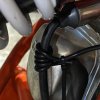I just installed a Runleader RL-HM032C tach on my bike. It's a fairly generic battery-operated inductive digital tach of the type you find all over Amazon and Ebay.
The revs seem to be reading unrealistically high. I'd like to know if anybody has any tips for getting this to read correctly.
I set the firing pattern to 1 spark per crank rev, and wrapped the signal wire around the plug wire 4 times, as instructed. However, in the operating instructions, it has this:

As I said, I have the wire wrapped around the plug lead 4 times, as instructed. But I have to wonder — how am I supposed to determine what's an accurate reading? If I had some way to know for sure whether the RPMs were too high or low, I wouldn't need the damn tach unit!
I am sure I'm no the only person to play with one of these, so any help would be appreciated.
The revs seem to be reading unrealistically high. I'd like to know if anybody has any tips for getting this to read correctly.
I set the firing pattern to 1 spark per crank rev, and wrapped the signal wire around the plug wire 4 times, as instructed. However, in the operating instructions, it has this:

As I said, I have the wire wrapped around the plug lead 4 times, as instructed. But I have to wonder — how am I supposed to determine what's an accurate reading? If I had some way to know for sure whether the RPMs were too high or low, I wouldn't need the damn tach unit!
I am sure I'm no the only person to play with one of these, so any help would be appreciated.






